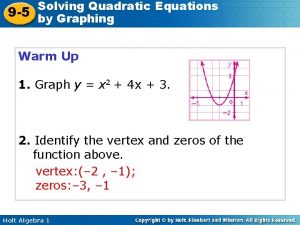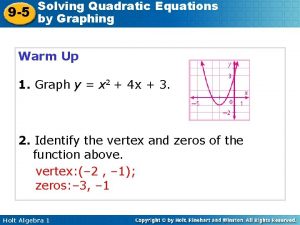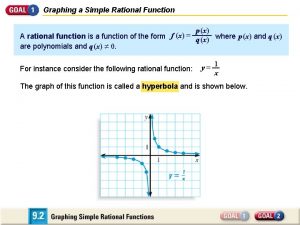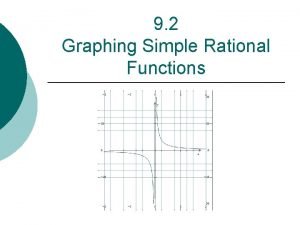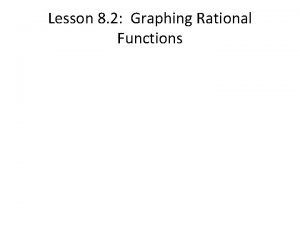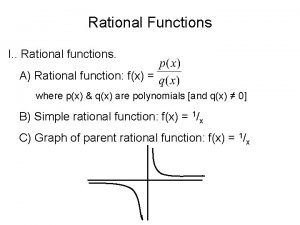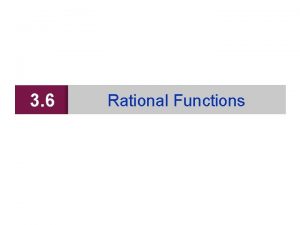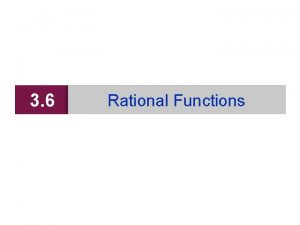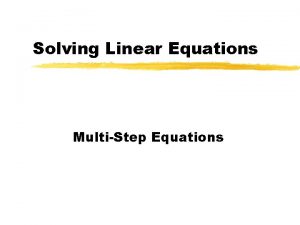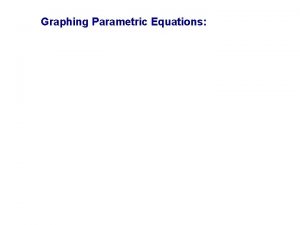Solving and Graphing Rational Functions Rational Equations A





















- Slides: 21

Solving and Graphing Rational Functions

Rational Equations A rational equation is an equation that has one or more rational expressions. Examples:

One way is to solve is to Cross Multiply!

Example

Example

Example

Solve by Graphing 1. Enter right hand side of equation into Y 1 and left hand side of equation into Y 2 2. Graph on an appropriate viewing window 3. Determine point(s) of intersection 4. Convert decimals to fraction solutions if needed

Example

Example

Rational Function The functions p and q are polynomials. The domain of a rational function is the set of all real numbers except those values that make the denominator, q(x), equal to zero.

Domain of a Rational Function {x | x – 4} or (- , -4) (-4, )

Domain of a Rational Function {x | x 2} or (- , 2) (2, )

Domain of a Rational Function {x | x – 3, 3} or (- , -3) (-3, 3) (3, )

Domain of a Rational Function {x | x – 3, 5} or (- , -3) (-3, 5) (5, )

Linear Asymptotes Lines in which a graph of a function will approach. Vertical Asymptote A vertical asymptote exists for any value of x that makes the denominator zero AND is not a value that makes the numerator zero. Example A vertical asymptotes exists at x = -5.

Asymptotes Vertical Asymptote Example A vertical asymptote does not exist at x = 3 as it is a value that also makes the numerator zero. A hole exists in the graph at x = 3.

Asymptotes Horizontal Asymptote A horizontal asymptote exists if the largest exponents in the numerator and the denominator are equal, or if the largest exponent in the denominator is larger than the largest exponent in the numerator. If the largest exponent in the denominator is equal to the largest exponent in the numerator, then the horizontal asymptote is equal to the ratio of the coefficients.

Asymptotes Horizontal Asymptote Example A horizontal asymptote exists at y = 5/2. A horizontal asymptote exists at y = 0.

Holes When a value of x sets both the numerator and the denominator equal to zero, then a hole is created. This means that there is a single point on the function that is not covered by the domain.

Holes Example The following functions have holes in their graphs: 1. f (x) = 2. f (x) =

Name all asymptotes and holes: 1. 2. 3.
 Solving quadratic equations by graphing and factoring
Solving quadratic equations by graphing and factoring Open dot and closed dot on a graph
Open dot and closed dot on a graph Absolute value lesson 1-3
Absolute value lesson 1-3 Solving graphing and analyzing quadratic functions
Solving graphing and analyzing quadratic functions 9-5 solving quadratic equations by graphing
9-5 solving quadratic equations by graphing 9-5 solving quadratic equations by graphing
9-5 solving quadratic equations by graphing Objectives of quadratic equation
Objectives of quadratic equation 9-3 practice solving quadratic equations by graphing
9-3 practice solving quadratic equations by graphing 9-3 solving quadratic equations by graphing
9-3 solving quadratic equations by graphing 2-7 solving equations by graphing
2-7 solving equations by graphing 5-2 solving quadratic equations by graphing
5-2 solving quadratic equations by graphing 9-5 solving quadratic equations by graphing
9-5 solving quadratic equations by graphing How to solve rational equations and inequalities
How to solve rational equations and inequalities 8-5 solving rational equations and inequalities
8-5 solving rational equations and inequalities Rational inequality
Rational inequality Rational equation and rational inequalities
Rational equation and rational inequalities 5-5 solving rational equations and inequalities
5-5 solving rational equations and inequalities How to solve rational inequalities algebraically
How to solve rational inequalities algebraically Solving equations with rational exponents
Solving equations with rational exponents Graphing rational numbers
Graphing rational numbers Algebra 2b unit 4
Algebra 2b unit 4 Graphing rational functions quiz
Graphing rational functions quiz





